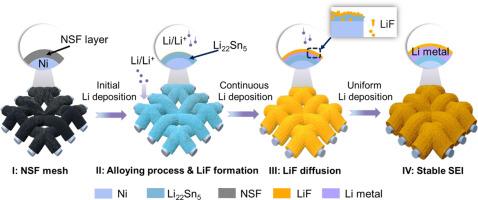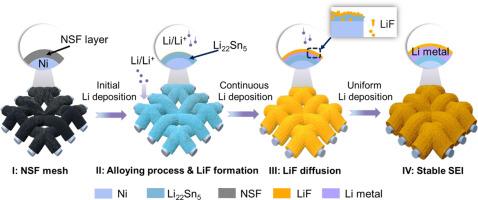高效锂电池用超薄锂金属阳极:表面LiF和亲锂合金化的协同作用
IF 20.2
1区 材料科学
Q1 CHEMISTRY, PHYSICAL
引用次数: 0
摘要
锂金属电池被认为是下一代储能系统最有前途的候选者之一。然而,诸如枝晶形成、不稳定循环和低锂利用率等挑战严重阻碍了它们的实际应用。在此,我们提出了一种通用且可扩展的制造超薄锂阳极的策略,即通过简单的sn_2气相反应将亲锂合金和金属氟化物涂层集成到集流器上。卷对卷系统可以在各种金属基板上进行可扩展的生产,如涂有Ni3Sn2和NiF2的Ni网所示。电化学锂沉积和熔融注入诱导原位Li-Sn合金形成和LiF表面迁移,协同实现均匀电镀、界面稳定和高锂利用率。该阳极具有3-10 mAh cm−2的可调面积容量,有效克服了厚度小于50 μm的锂箔的制造限制,并显著降低了锂消耗。具体来说,容量为3.4 mAh cm−2的超薄锂阳极在对称电池中表现出2200小时的稳定循环。在0.5℃下,使用LiFePO4阴极的电池在200次循环中平均库仑效率为99.8%。本文章由计算机程序翻译,如有差异,请以英文原文为准。


Ultrathin lithium metal anodes for high-efficiency lithium batteries: synergizing surface LiF and Lithiophilic alloying
Lithium metal batteries are considered one of the most promising candidates for next-generation energy storage systems. However, challenges such as dendrite formation, unstable cycling, and low lithium utilization have severely hindered their practical implementation. Herein, we propose a universal and scalable strategy for fabricating ultrathin lithium anodes by integrating lithiophilic alloys and metal fluoride coatings onto current collectors through a simple SnF2-based gas-phase reaction. A roll-to-roll system enables scalable production on various metal substrates, as demonstrated by Ni mesh coated with Ni3Sn2 and NiF2. Electrochemical lithium deposition and molten infusion induce in situ Li-Sn alloy formation and LiF surface migration, which synergistically enable uniform plating, interface stabilization, and high lithium utilization. The resulting anodes deliver tunable areal capacities of 3–10 mAh cm−2, effectively overcoming the fabrication limitations of lithium foils thinner than 50 μm and significantly reducing lithium consumption. Specifically, ultrathin lithium anodes with a capacity of 3.4 mAh cm−2 exhibit stable cycling over 2200 h in symmetric cells. Full cells with LiFePO4 cathodes deliver an average Coulombic efficiency of 99.8 % over 200 cycles at 0.5 C.
求助全文
通过发布文献求助,成功后即可免费获取论文全文。
去求助
来源期刊

Energy Storage Materials
Materials Science-General Materials Science
CiteScore
33.00
自引率
5.90%
发文量
652
审稿时长
27 days
期刊介绍:
Energy Storage Materials is a global interdisciplinary journal dedicated to sharing scientific and technological advancements in materials and devices for advanced energy storage and related energy conversion, such as in metal-O2 batteries. The journal features comprehensive research articles, including full papers and short communications, as well as authoritative feature articles and reviews by leading experts in the field.
Energy Storage Materials covers a wide range of topics, including the synthesis, fabrication, structure, properties, performance, and technological applications of energy storage materials. Additionally, the journal explores strategies, policies, and developments in the field of energy storage materials and devices for sustainable energy.
Published papers are selected based on their scientific and technological significance, their ability to provide valuable new knowledge, and their relevance to the international research community.
 求助内容:
求助内容: 应助结果提醒方式:
应助结果提醒方式:


